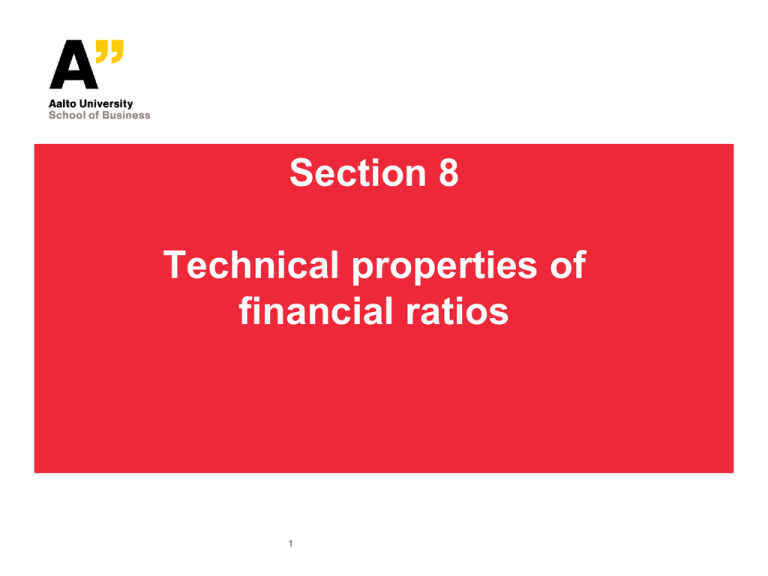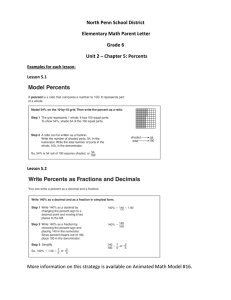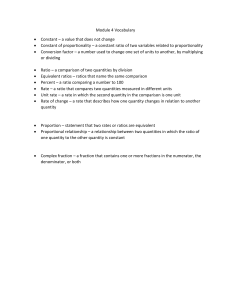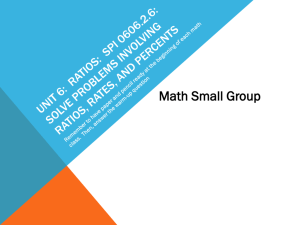8. Technical properties of financial ratios
advertisement

Section 8 Technical properties of financial ratios 1 Learning objectives After studying this chapter, you will understand: • Why financial statement information is used in the ratio form • Assumptions in calculating financial ratios • Why these assumptions are often violated 2 Why ratios? • Financial data are usually summarized in a ratio form – Financial statement numbers are divided by other financial statement numbers • Financial ratios control for the effect of firm size accross firms and over time Financial statement numbers are combarable across firms and years 3 Why ratios? • Consider following example of summarizing financial data in the ratio form: Earnings: Sales: Profit margin (Earnings/Sales): • • Firm A 10 milj. 100 milj. Firm B 2 milj. 8 milj. 10% 25% Earnings of Firm A are higher than those of Firm B However, Profit margin reveals the true profitability 4 Proportionality • An important assumption in using financial ratios is the socalled proportionality between the numerator and denominator • Strict proportionality implicates that 1. there should exist a linear relationship between the numerator and denominator of the ratio 2. this relationship should not contain any constant term • Empirical evidence indicates that the proportionality assumption is usually full-filled 5 Strict proportionality • E = Earnings, S = Sales and r is the ratio of Earnins-toSales: E r S E rS • Under strict proportionality assumption, the relationship between the numerator and denominator is linear and there is no constant term in the relationship 6 Deviations from strict proportionality assumption 1. Proportionality without constant Earnings 3. Non-proportionality without constant Earnings Sales Sales 2. Proportionality with constant 4. Non-proportionality with constant Earnings Earnings Sales 7 Sales Technical issues in calculating financial ratios • Small or zero denominators – If the denominator of the financial ratio is equal to zero, the ratio cannot be calculated – If the value of the denominator is close to zero, the ratio is close to infinity – If the denominator fluctuates a lot across years or firms, the values of ratio fluctuate a lot, too • Following example of P/E- and E/P-ratios illustrates the problem of small or zero denominators 8 Technical issues in calculating financial ratios • Outliers refer to the extreme values of a given financial ratio – Outliers are inconsistent with the remaining data • There may be several reasons for outlier observations – Data recording errors – Technical issues such as close to zero denominators – True indication of the extreme state of the underlying firm characteristic (e.g. bankcuptcy firms) • Outlier observations are usually deleted from the data, but one should be very careful when doing so – Important information may be lost, if the outlier reflects the true economic state of the firm 9 Common-size analysis • Common-size analysis refers to the standardization of items in income statement and balance sheet – Financial items are expressed as percentage of a chosen item that measures the scale of the operations – Common-size analysis helps comparing financial statements 10 Example: the common-size analysis EUR % Sales 31191 100.0 Operating expenses -19787 -63.4 Operating income -2985 -9.6 Depreciations -3443 -11.0 EBIT -714 -2.3 Interest payments -80 -0.3 Tax -518 -1.7 Net profit -302 -1.0 Distributional properties of financial ratios • Financial ratios are compared across firms and years • This comparison requires some knowledge on the distributions of ratios – Financial analysts may intuitively use a prior distribution of the variable that is of interest – Some of the analyses methods such as credit rating or bankruptcy prediction are based on statistical tools that assume a certain distribution – Financial data can also be summarized by calculating averages or other parameters of the ratio distributions 11 Normal distribution • Distributions can have many different type of shapes • We often focus on the normal distribution • Normal distribution can be described by only two variables – Mean – Standard deviation • Some of the frequently used statistical tools used to analyze financial variables assume that the data are normally distributed 12 Empirical evidence on ratio distributions • Empirical evidence indicates that financial ratios are often non-normally distributed • Typical reasons for non-normality include: – Strict proportionality assumption between the numerator and denominator of the ratio may cause skewness – Some financial ratios have technical limits, e.g. in zero • Current ratio, Quick ratio – Some financial ratios may have economic limits • Accounts receivables turnover – Outlier observations may cause peaked distributions 13 How to achieve normality? • Non-normal ratio distributions can be converted to normal ones by using at least following methods – deleting observations that deviate most from normality – resetting extreme observations to less extreme values – transforming ratios with a certain function • • • • square root transformation cubic root transformation logarithmic transformation inverse transformation – recognize non-normality in decision making without attempting to transform distribution 14 Example: Square root transformation Value of the original financial ratio 1 2 3 4 5 6 7 8 15 Value of the transformed financial ratio 1,00 1,41 1,73 2,00 2,24 2,45 2,65 2,83 Evidence on ratio distributions • Kallunki (1998) reports empirical evidence on the impact of transformation to the normality of the financial ratios: Year 1989 1990 1991 1992 1993 ROI 0.90*** 0.97 0.98 0.96 0.85*** Year ROI 1989 1990 1991 1992 1993 0.98 0.86*** ETS CR QR INT 0.84*** 0.81*** 0.87*** 0.85*** 0.90*** 0.79*** 0.82*** 0.87*** 0.83*** 0.92*** 0.82*** 0.77*** 0.73*** 0.81*** 0.80*** ETS CR QR INT 0.97 0.96 0.92*** 0.98 0.97 0.95* 0.98 0.97 0.98 0.98 0.97 0.97 0.97 0.96 0.99 0.97 0.97 0.99 0.85*** 0.98 0.97 0.94** 0.91*** Notes: The numbers in the table are the values of the Shapiro-Wilk’s test statistic for testing the normality of financial ratios. * significant at level of 10 percent, ** significant at level of 5 percent *** significant at level of 1 percent 16 ’Raw’ data Transformed data Summary • Financial data are usually summarized in a ratio form to control for size of the firm • There should be a proportionality between the numerator and denominator of the financial ratio • Outliers are often a problem in ratio analysis • We need to have some idea about the distribution of the financial ratio • Financial ratios are transformed to achieve a better distribution




